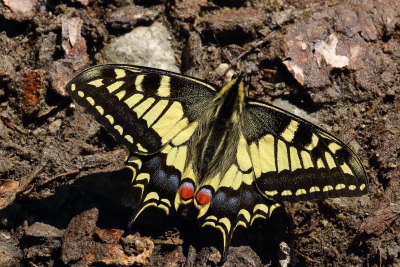


















Swallowtail (Papilio machaon)
2024 photographs highlighted in yellow. Click on any photograph to go to an enlarged picture, or simply scroll down the page.
|
This huge and utterly magnificent butterfly is not uncommon in southern France, but usually seen in singles or small numbers, but in one or two locations there have been as many as six puddling together.
Because it is so large, it is almost unmissable. In England the subspecies is britannicus (the European subspecies is gorganus) which has a paler yellow colour and darker marginal regions, and is confined to a small area of the Norfolk Broads, but in France it is distributed over a wide variety of terrain including mountainous areas and its larval hostplant requirements are quite different. |
It is often quite hard to photograph as its wings are constantly moving even when it is nectaring, possibly because it is a (comparatively) heavy butterfly, and needs to keep the wingbeats high to assist buoyancy.
I particularly like the "shower" of blue cells in the uph black band, reminiscent of a firework display or a comet.
The only butterfly it could be confused with is the inaptly-named Scarce Swallowtail (Iphiclides podalirius), or if you are very lucky, the very scarce (now this one is scarce) Southern Swallowtail (P. alexanor). |
| ref | sex |
observations |
alt. m |
| 18156 | M |
a male, puddling. |
1120 |
| 7970 | M |
a male, taking salts. I rather like the three Southern Small Whites (Pieris mannii) which seem to be lined up and staying a respectful distance behind the "king". |
900 |
| 45378 | M | a male, puddling. It is particularly dark and has a strong yellow colour. | 1400 |
| 52413 | M | a male, one of a group of four puddling in close proximity. | 1550 |
| 51780 | F | a female, egg-laying on a plant species that I think is Peucedanum gallicum, a species related to Hog Fennel. 51808 is the upperside. | 170 |
| 51808 | F | a female, the same species as 51780, so known to be a female. Pristine and immaculate. I spent over an hour just watching it. | 170 |
| 50411 | ? | this was just warming up on a rather cloudy morning, so stayed in this pose for quite some time. This is a species that always seems fresh and rarely shows signs of wear. Whether this is a function of the structure of the scales or whether it just doesn't survive longer enough to show signs of wear, is not clear, but more probably the former. | 280 |
| 9476 | ? |
this shows the width and wing area of this magnificent butterfly. It's a pity that the right hand tail is missing, but this is probably an effective defence measure, as it was probably lost to a predator who thought it was attacking the vulnerable head end of the insect. |
920 |
| 12699 | M |
a male, puddling for salts. One of the few occasions it stays still and open enough for a decent photograph opportunity. |
1120 |
| 14097 | ? |
photographed on the move, as it was nectaring. |
920 |
| 35817 | ? | a female possibly, flying at high altitude. It is rather pale compared to others on this page, and appears to have a part of the chrysalis still attached to the back of its head. | 2100 |
| 44572 | ? | a rather yellow specimen, possibly female. | 1550 |
| 15140 | pair |
a mating pair. The first time I have ever seen this, and quite probably the last. |
340 |
| 45263 | M | a group of six males puddling together, plus a single podalirius. I don't think I have ever seen so many machaon puddling together. | 1550 |
| 18317 | M |
a male puddling in company with another machaon and many other species. |
1120 |
| 2712 | M |
this was acting in a very un-swallowtail-like way, to my eyes. It was circling around the bush, returning to the same perch (the top-most point on the bush, about 2.5m high) each time, as if guarding its territory. It did facilitate a shot of the underside, even if from a distance of about one metre (I have blown up the photograph for detail). It was a fabulous fresh specimen, with very light and delicate markings, that may have just emerged. |
10 |
| 52842 | M | a male puddling with wings folded, quite striking. | 1230 |
| 9588 | larva |
a larva, feeding on Fennel (Foeniculum vulgare), I believe. |
|
| 15588 | ovum |
an ovum, laid on a plant that I don't think is Fennel, the normal larval hostplant and quite common in Var. Machaon does have a wide variety of larval hostplants, and I think the plant in 15588 is probably related to Fennel. Any advice would be welcome. |
200 |
| 35616 | ovum | an egg which appears to have been laid on Fennel. | 370 |
52413_male_Alpes-Maritimes_1Jul24
35817_sex?_Alpes-Maritimes_2Jul14
44572_sex?_Alpes-Maritimes_18Jul17
45263_male_Alpes-Maritimes_3Jul18